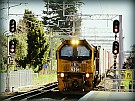Advanced traffic management system – ATMS
A tool that uses technology to monitor and improve the flow of vehicle traffic and safety on congested roadways.
alliance
A grouping of people who agree to work together.
asset
Something that is useful or has value for example, a house is an asset; good health is a great asset.
Closed circuit television (CCTV) cameras
The use of video cameras to transmit a signal to a specific place, on a limited set of monitors.
congestion
A condition on a road that occurs as use of that road increases. It is characterized by slower speeds, longer trip times, and increased queues.
economic growth
The increase in value of goods and services of a country. Often measured by the ‘gross domestic product’ (GDP) as an annual percentage.
electrified rail
Trains operate from electricity transmitted through overhead wires.
gantry
A bridge-like overhead structure with a platform supporting equipment such as electronic signals, signs or cameras.
green corridor
Areas of natural vegetation in between man-made activities or structures (such as roads) that are connected and enable wildlife populations to move along them.
intersection
A place where two or more roads meet.
lane control sign
Electronic sign with three display options: changing the speed limit; closing a lane; directing drivers to change lanes.
level crossing
The point at which the railway crosses over either a public or private road on the same level.
loop (telecommunication)
Sending a signal on a channel and receiving it back at the sending terminal.
median barrier
A protective divider that physically separates opposing traffic flows and helps stop vehicles travelling into opposing traffic lanes.
modelling
Computer modelling means using a computer to ‘model’ situations to see how they are likely to work out if you do different things.
motorway
A dual-carriageway road designed for fast traffic, with relatively few places for joining or leaving.
NZ Road Code
A guide to New Zealand road law and safe driving practices https://www.nzta.govt.nz/resources/roadcode/
New Zealand Transport Agency – NZTA | Waka Kotahi
New Zealand Crown entity tasked with promoting safe and functional transport by land, including the responsibility for driver and vehicle licensing and investigating rail accidents. They also fund, together with local and regional government, local roads and public transport infrastructure and services.
off-ramp
An exit lane for traffic from a main road, usually a motorway or highway.
on-ramp
An entrance lane for traffic to a main road, usually a motorway or highway.
public transport
Bus transport is the main form of public transport in New Zealand. Auckland and Wellington also have suburban rail systems. Some cities also operate local ferry services. Aeroplanes are also part of the public transport network.
radar
An object-detection system that uses radio waves to determine the range, altitude, direction, or speed of objects.
rail corridor
The land that the rail tracks run along, which is out of bounds to the public to ensure peoples' safety.
ramp signal
A traffic light at the end of an on-ramp which directs traffic to enter a motorway at a rate that allows traffic to merge easily with the mainline flow.
sensors
Count the traffic and the speed at which it's travelling.
State Highways
Major national roads in a network. They consist of SH 1 running the length of both islands; SH 2-5 and 10-58 in the North Island, and SH 6-8 and 60-99 in the South Island. State highways are marked by red shield-shaped signs with white numbering.
unified
Brought together to form a single unit.
urban design
The layout of part of an urban area, such as a park or area of roads and their surroundings, chosen by experts to best fit in with the needs of the community and natural environment.
variable message sign
A large number of permanent and temporary message signs are located throughout the country, to provide real-time information for drivers while they are driving.




